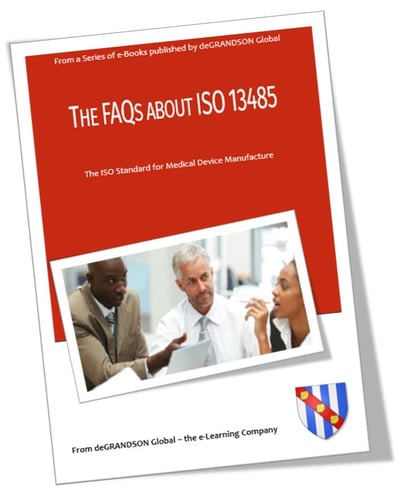
We've gathered all the common ISO 13485 questions
about Certification together with expert answers.
Download the Free ISO 13485 Certification e-Book for answers
Here, we at deGRANDSON Training, a provider of ISO 13485 training, have assembled a comprehensive set of ISO 13485 Certification FAQS...
The Questions Answered
- What is ISO?
- What is ISO 13485?
- What is the purpose of ISO 13485?
- What is a Medical Device Management System (MDMS)?
- What is the Purpose of a Medical Device Management System?
- Who Needs a Medical Device Management System?
- What are the Benefits of a Medical Device Management System?
- What is ISO 13485 Certification?
- Do You Need ISO 13485 Certification?
- Who needs ISO 13485 Certification?
- Does ISO 13485 Certification require the services of a Notified Body?
- What are the Benefits of ISO 13485 Certification?
- Is ISO 13485 Feedback the same as ISO 9001 Customer Satisfaction?
- Why does ISO 13485 call for documentation many times while ISO 9001 does not?
- Is ISO 13485 intended for Medical Device Manufacturers only?
- Do applicable regulatory requirements mentioned in ISO 13485 include ISO 14971 and other ISO Standards?
- How much does ISO 13485 Certification Cost?
- Who issues ISO 134851 Certification Certificates?
- How to get an ISO 13485 Certificate
- How to Choose a Certification Body?
- Are online ISO 13485 Certificates you can get within 30 days legitimate?
- Why is it Important to Get Certified by the Proper Certification Body?
- How does the ISO 13485 Certification Process Go?
- How to check the ISO 13485 Certification of an organization?
- Do Management Representatives or others responsible for an MDMS need training?
- Do Internal Auditors need training?
Click on the e-Book image to get your copy.
Do you have a Question we still need to answer?
We'd love to hear it and, if possible, answer it for you. Just use our Support Ticket System. You'll find a Knowledge Base there that might have an immediate answer for you. Otherwise, fill in a Ticket.
If you would like more, please visit deGRANDSON Support Ticket.
Related Articles
- ISO Training Courses Overview
- ISO Auditor Certification: Boosts your Job Prospects
- ISO 14971 Medical Device Risk Management - Foundation
deGRANDSON Global is an ISO Certified Educational Organization
In October 2021, we secured certification to three education-related ISO Standards. We now have a university-grade management system in place conforming to the requirements of …
We have chosen ISO 21001 certification because, unlike IRCA and Exemplar badges (which, in our opinion, are commercially compromised), it is based on independent third-party assessment. It is a ‘university grade’ standard globally by schools, colleges, and universities to demonstrate competence.
